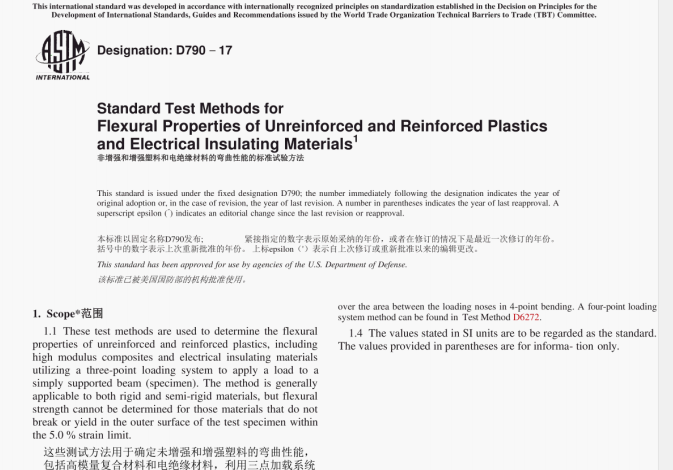ASTM D790:17 pdf download.Standard Test Methods for Flexural Properties of Unreinforced and Reinforced Plastics and Electrical Insulating Materials.
Since this is not always the case, a slight error will be introduced if Eq 3 is used to calculate stress for materials that are not true Hookean materials. The equation is valid fhr obtaining comparison data and for spccitication purposes. but only up to a maximum fiber strain of 5 % in the outer surface of the test specimen for specimens tested by the procedures described herein.
NOTE 6—When testing highly orthotropic laminates, the maximum stress may not always occur in the outer surface of the test specimen.4 Laminated beam theory must he applied to determine the maximum tensile stress at failure. If Eq 3 is used to calculate stress, it will yield an apparent strength based on homogeneous beam theory. This apparent strength is highly dependent on the ply-stacking sequence of highly orthotropic laminates.
5. 1 .2 Flexural Stress /br Beams Tested at Large Support
Spans —If support span-to-depth ratios greater than 16 to 1 are used such that defiections in excess of 10 % of the support span occur, the stress in the outer surface of the specimen for
a simple beam is reasonably approximated using equation (Eq 4) in 12.3 (see Note 7).
NOTE 7— When large support span-to-depth ratios are used, significant end forces arc developed at the support noses which will affect the moment in a simple supported beam. Eq 4 includes additional terms that are an approximate correction factor for the influence of these end forces in large support span-to-depth ratio beams where relatively large deflecLions exist.
5.1.3 Flexural Strength (0,M)— Maximum flex ural stress sustained by the test specimen (see Note 6) during a bending test. It is calculated according to Eq 3 or Eq 4. Some materials that do not break at strains of up to 5 % give a load deflection curve that shows a point at which the load does not increase with an increase in strain, that is, a yield point (Fig. 1, Curve b), Y. The flexural strength is calculated for these materials by letting P (in Eq 3 or Eq 4) equal this point, Y.
5. 1 .4 Flexural OJfrer Yield Strength—Offset yield strength is the stress at which the stress-strain curve deviates by a given strain (offset) from the tangent to the initial straight line portion of the stress-strain curve. The value of the offset must he given whenever this property is calculated.
NOTE 8—Flexural Offset Yield Strength may differ from flexural strength defined in 5.1.3. Both methods of calculation are described in the
annex to Test Method D638.
5.1.5 Flexural Stress at Break (t)—Flexural stress at break of the test specimen during a bending test. It is calculated according to Eq 3 or Eq 4. Some materials give a load deflection curve that shows a break point, B, without a yield point (Fig. 1, Curve a) in which case GIM. Other materials give a yield deflection curve with both a yield and a break point. B (Fig. 1, Curve b). The flexural stress at break is calculated for these materials by letting P (in Eq 3 or Eq 4) equal this point, B.
ASTM D790:17 pdf download
